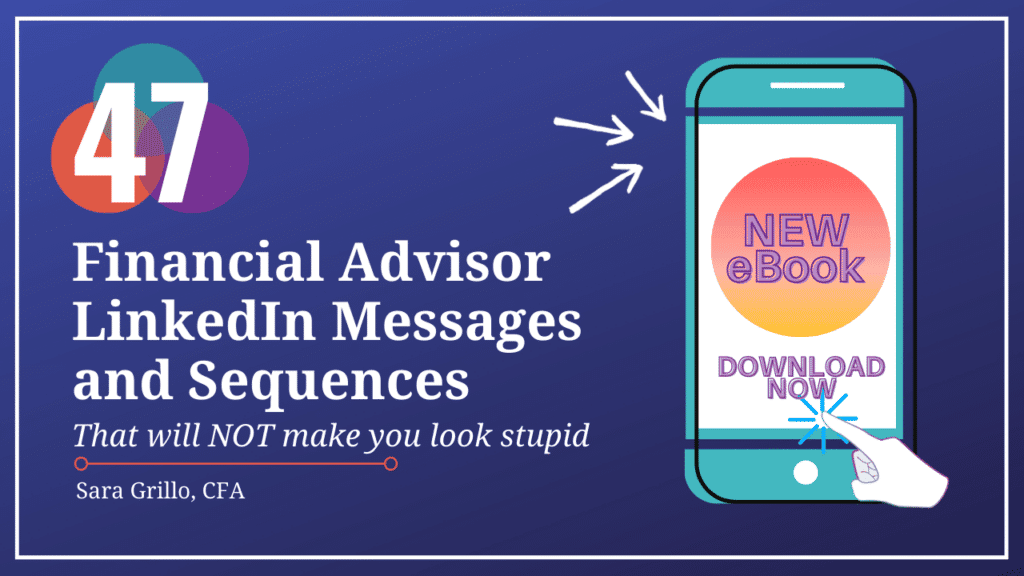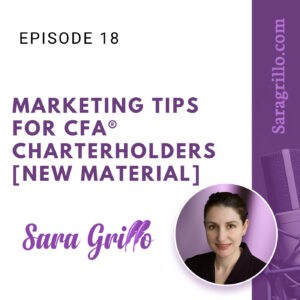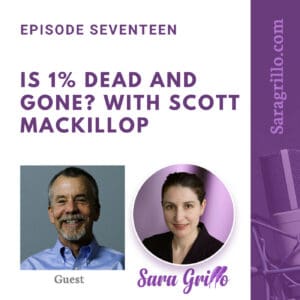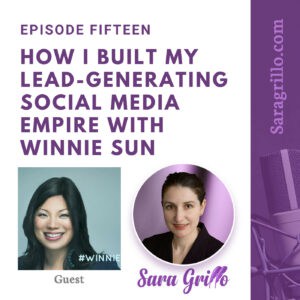Podcast: Play in new window | Download
The insurance industry has a complex landscape and as we all know there’s alot of smoke and mirrors marketing that happens with agents pushing crap products. No one person can know everything about each of these products, sometimes even the insurance agents themselves don’t have a complete understanding of the products they are selling. In this podcast, Patrick Waters of Peak Pro Financial discusses some of the complexities of insurance products like IUL, how the purchasing process can be made more transparent for buyers by mapping out the IRR, what it may teach us about a policy, what it won’t teach us, and most interestingly, the impact of AG-49 on product marketing.
For those of you who are new to my blog, my name is Sara. I am a CFA® charterholder and financial advisor marketing consultant. I have a newsletter in which I talk about financial advisor lead generation topics which is best described as “fun and irreverent.”

And now – let’s get onto the show!
How to find an IRR of an insurance product: crash course
Patrick begins with an explanation of IUL’s and how they are associated to an IRR. He provides a basic cash flow model of intake and spending, where variations in rates can make these two parts of the process more or less equitable. This he describes as being different than a traditional time value of money process.
He says that this calculation includes client withdraws, as well as a potential death value in case the death benefits are paid out during the life of the account. He believes that this formula is ‘cleaner’ than a more tradition process, because it’s simply a cash in/cash out formula, with no taxes or hidden fees.
AG-49 muddied the waters for IRR
Patrick also discusses AG-49 (Actuarial Guidance 49). What is AG-49, anyways?
This regulation resulted from IUL’s being advertised as higher rates than they should be. AG-49 puts a ceiling on the rates that IUL’s can be rated. He uses the example that one single year’s performance, even if that particular year was an outlier, could be almost falsely used to represent the potential return rate for a product. This misrepresentation would lead to people purchasing these insurance financial products with expectation that were highly unlikely to be met.
Patrick explains that instead of these unethical practices, an index is used that takes the average performance of a product over a lengthy amount of time, say 20 or 50 years, and caps an index rate that the product can be advertised for. This cap provides a ceiling that the carrier must adhere by which they can run their illustrations for that particular product. Even though the index is computed by the carrier themselves, it must be explicit in the policy, and offer the potential buyer the option of using the index or not. This will create transparency by which they can allocate their products, and since the rates are indexed upon a longitudinal summary projection, their expectations are made more realistic.
Another feature of the AG-49 is that they capped the arbitrage inside the policies, which is at 50 basis points. Patrick explains the (admittedly complex) concept of arbitrage inside an IUL policy. This allows money to be borrowed at a low fixed rate, while the initial capital is growing, which is what Patrick says makes the IUL attractive to investors in the first place. AG-49 caps the arbitrage at 50 basis points in a policies illustration.
What AG-49 means for IRR and complex insurance products
Let’s talk about what you should think about as you find the IRR of a policy, why you really should look at it before you buy the policy and what its limitations are.
Patrick gives a number of examples on an excel spreadsheet to help illustrate these concepts. He makes the claim that because of AG-49, IRR inside of an IUL is basically worthless. To show the impact of AG-49, he uses the pre AG-49 example of a 57-year-old who invested $50,000 for five years, and started making withdraws of $31,000 each year at age 65. This investment generated a 7.45% IRR. The same illustration after AG-49 is implemented has a return rate of 4.5%. He says that before AG-49, people had unrealistic expectations about the performance of their initial investment.
He uses a couple other models to demonstrate his point, which is that many of the illustrations for these products do not represent a realistic expectation, even with yearly level retirement payouts. This is because the predicted rate of return is not representative of a likely return rate. He does not believe that many of these products are sustainable, largely due to the increasing volatility of the market. Patrick is clear that you should not sell an IUL with the allure of market-like returns.
IRR is not a guarantee!
He wants people to know that the IRR on an IUL is an unknown, and no model can successfully predict the true performance of a product in the future. He recommends that advisors examine their client’s portfolio individually before suggesting an IUL (or any other insurance products), there is no one size fits all point of advice, and each person should be informed realistically of the cost of the policy and the unpredictability of the performance.
Who should IUL be sold to?
Patrick says that most people simply don’t understand how IUL’s are produced and financed, and they are typically only useful for people with a very high net worth, not so much for people who are looking for a safer 401(k) type of investment plan. Knowing the IRR can cut through some of the confusion but it’s not the only metric that matters and in cases like this, it doesn’t mean very much. Hence it should not be the sole basis for the consumer’s decision.
An IUL is not a Swiss Army Knife!
Patrick says the IUL’s are useful for some people, but the insurance industry should be particular in who they all these products to. He says that IUL’s are seen by naïve people as a type of financial Swiss army knife. It’s not an efficient vehicle for long term care, for instance people who will need yearly payouts to subsidize their retirement.
Most people, including most insurance agents, don’t really understand how an IUL works.
You see how confusing this can get, right?
Patrick suggests people without expertise in this area might be benefited by David McKnight’s books, and to research how IUL’s correlate with other asset classes for a better understanding and help with the decision making process about whether an IUL is right for them.
David McKnight and Ed Slott, The Power of Zero
David McKnight and Ed Slott, Tax-Free Income for Life
He invites people to contact Patrick directly on LinkedIn if they have question they feel he could help them answer.
Sara’s upshot on why the IRR matters
I’m sick of smoke and mirrors marketing. Are you? Map out the IRR for your clients, because it may be helpful. But in certain aspects it is very lacking. Most of all, know what they need and what you are really recommending to them, and use a plethora of available metrics to increase transparency of the insurance products you are recommending, or analyzing on their behalf.
And if you are in marketing mode…
Learn what to say to prospects on social media messenger apps without sounding like a washing machine salesperson. This e-book contains 47 financial advisor LinkedIn messages, sequences, and scripts, and they are all two sentences or less.

You could also consider this LinkedIn training program which teaches financial advisors how to get new clients and leads from LinkedIn.

Thanks for reading. I hope you’ll at least join my weekly newsletter about financial advisor lead generation.
See you in the next one!
-Sara G
Disclosures
Grillo Investment Management, LLC does not guarantee any specific level of performance, the success of any strategy that Grillo Investment Management, LLC may use, or the success of any program mentioned herein. Nothing in these materials may be construed as an investment, insurance, or financial recommendation. For such a recommendation, consult with a financial advisor.
Grillo Investment Management, LLC will strive to maintain current information however it may become out of date. Grillo Investment Management, LLC is under no obligation to advise users of subsequent changes to statements or information contained herein. This information is general in nature; for specific advice applicable to your current situation please contact a consultant or advisor. Grillo Investment Management, LLC does not claim that any of the information presented herein is accurate and can not be held accountable for the results of any actions taken based upon such information. The views expressed by guests do not necessarily represent those of Grillo Investment Management, LLC. Forward looking projections are entirely hypothetical in nature and may not be interpreted as guarantees of any sort. Please conduct your own modeling and research before undertaking any type of security or insurance policy transaction, and consult with a financial, tax, or insurance advisor.





